What Are Cannabis Chemotypes And Chemovars?
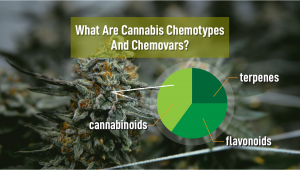
- 1. The origins of chemovars in research
- 2. Strains, chemotypes and chemovars
- 2. a. Strain
- 2. b. Chemotypes
- 2. c. Chemovars
- 3. What are the different chemotypes in cannabis?
- 3. a. Type 1: thc dominant
- 3. b. Type 2: balanced thc/cbd ratio
- 3. c. Type 3: cbd dominant
- 3. d. Type 4: cbg dominant
- 3. e. Type 5: zero cannabinoids
- 4. Cannabis chemovars: the next big thing?
- 5. In conclusion
Before the “modernization” of cannabis seeds, consumers used to refer to a strain’s effect by the species (Indica or Sativa). More recently, cannabis hybrids emerged and allowed different cannabis strains with mixed effects as Hybrids but, as research continues, more and more categories appear, which leads us to chemotypes and chemovars. Despite not seeming super important, chemotypes and chemovars allow us to differentiate a certain strain or plant by the chemical compounds it produces, making it easier to know the effect it provides. Apart from the type of high, chemotypes give cannabis consumers the entire chemical profile of a certain plant, allowing you to have a better idea of what to expect when consuming a certain strain and if it will help treat certain symptoms you may want to deal with if you’re a medical consumer. On the other hand, chemotypes will also help researchers understand how cannabinoids, terpenes, and all the chemical compounds in cannabis influence our body, which will help evolve the cannabis industry, so let’s learn about chemotypes and chemovars.
Ultimately, these new classifications will help both scientific research and consumers alike. Despite the widespread use of the terms “Sativa” and “Indica” in popular cannabis culture, they are rarely used correctly. Botanically speaking, these names are given to two distinct subtypes of cannabis. Each of these subtypes developed in different parts of the world. Because of this, they feature differences when it comes to their morphology, meaning the way that they look. However, mainstream cannabis culture took these terms and started to attribute them to specific effects exerted by particular strains. This led to the common misconception that Indica strains always produce a stoning and physical effect, while their Sativa counterparts never fail to exert an energizing and cognitive high. However, their names refer to their morphology, not the chemical constituents that underpin their effect. Some strains that display an Indica morphology are able to produce energizing effects, and some taller and more slender Sativa varieties are capable of delivering more of a stoning sensation. THC forms the core of the psychoactive cannabis experience, but its aromatic molecules known as terpenes are responsible for the different effects among different strains. New classification systems offer users and researchers much more insight into a cultivar, instead of just information on its morphology and nothing more than guesswork when it comes to its unique chemical content.
1. The Origins of Chemovars in Research
The first time “Chemovar” was mentioned was in a study called Cannabis: From cultivar to Chemovar by Arno Hazekamp, in which he claims that in order to classify cannabis cultivars correctly we would have to identify and quantify the chemical compounds found in all cannabis types. This study tested over 30 samples and identified around 28 different cannabinoids and terpenes in 0.5mg of cannabis flower. Since then, another study published by the same researcher studied 460 samples and found over 44 different cannabinoids and terpenes.
Another study conducted in Italy found 135 different cannabinoids and terpenes in 50 samples of cannabis flowers. With all these data, researchers were able to define groups for the main 4 chemotypes, which resulted in 9 different types of cannabis, based on their cannabinoid profiles. But researchers claim that chemovars are better than chemotypes if you want to predict a certain cultivar’s effect although more research needs to be conducted for more precise information. This can help consumers identify the most popular chemovars and group them according to the effects, making it much, much easier to find the best option to treat a certain condition while making it easier for healthcare professionals to prescript cannabis for those who need it.
How Can Consumers Benefit from the Different Chemovars?
As mentioned, the chemovar approach is much better than trial and error and can be of great help, especially for medical patients who know what they need. The chemovar approach groups cannabis based on the cannabinoid and terpene content. So for example, if you need to treat headaches and migraines, the chemovar approach makes it easier to find the right strain or product as you’ll already know the most effective chemovar type, in this case, that would be chemovar type 1. So remember that if you want to take the chemovar approach, make sure to check the label on the cannabis product and look at the dominant cannabinoids and terpenes. Once you have this information, make sure to take a look at our table further in this article where you’ll learn everything you need to make the right choice when shopping at your dispensary of choice.
2. Strains, Chemotypes and Chemovars
Despite what most consumers believe, strain names cannot be used to precisely understand the effect you’ll experience, it can give you an idea but due to the multiple variations a strain has, it’s not very precise. Fortunately, research led to scientists finding a new way to categorize cannabis (apart from strains), they are Chemotypes and Chemovars.
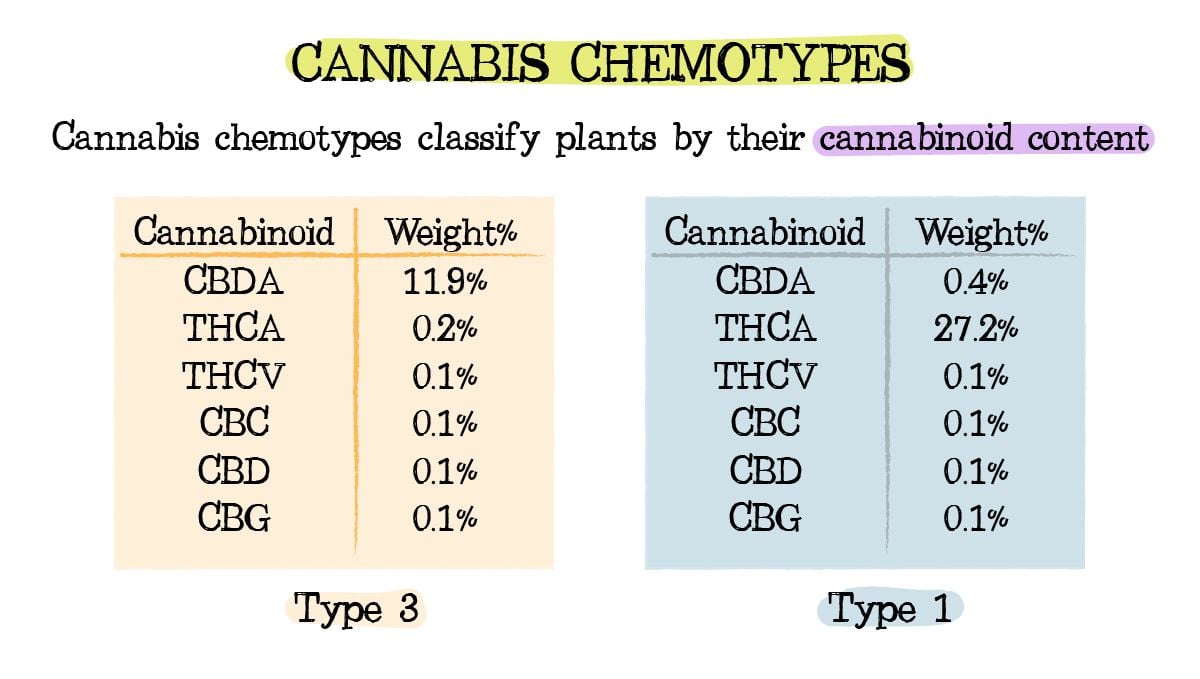
These words refer to the chemical compounds found in a cannabis plant, such as cannabinoid content and terpene profile among others, which is what determines the type of high you’ll experience.
Strain
Strain is the name given to a cannabis variety that shares a certain genetic similarity but it’s not very precise because, for example, you can buy OG Kush flower in one dispensary and be completely different from the OG Kush flower you buy at another dispensary, and sometimes, even the flower from the same dispensary can have a different aroma and effect due to being from different batches. This happens due to the phenotypic variations a plant within a certain strain can have.
Chemotypes
Chemotypes are a way to categorize cannabis plants by their cannabinoid content. Meaning that chemotypes categorize cannabis plants mainly by their most abundant cannabinoid (such as THC or CBD). Chemotypes categorize strains by the ratio of cannabinoids and divides cannabis plants into Type 1 for THC-dominant plants, Type 2 for 50/50 THC and CBD plants, and Type 3 for CBD-dominant plants.
Chemovars
Just like chemotypes, chemovars also categorizes cannabis plants by their chemical compounds but takes into consideration at least two abundant cannabinoids and the two, three, or four main terpenes found in cannabis plants. A good way to understand these terms is by comparing them to cheese, for example. If you eat cheese regularly it means you like it, but it doesn’t mean that you eat any kind of cheese. In most cases, you’ll probably prefer a type of cheese that comes from a certain place or with a specific aroma or flavor such as “cheddar” and “gorgonzola”.
When talking about cannabis, it’s kinda similar to the example given before but due to not having standard labels that categorize cannabis plants by their characteristics, researchers are coming up with new ways to do so and discovered that by looking at the chemical compounds found in a cannabis plant, you can basically predict its effects.

Now, obviously, the strain’s name is a way to do so but it isn’t precise due to the multiple variations a strain can have. This means that if you buy, a certain flower at a dispensary, the effect, aroma, and flavor might be slightly or completely different the next time you buy it because what actually determines these characteristics is the cannabinoid and terpene content and not the name of the strain.
So, by knowing the chemical compounds and their concentrations, you can find a different strain that provides the same effects as the OG Kush, for example, making it easier to find the cultivar that suits your needs.
2. What Are The Different Chemotypes In Cannabis?
Chemotypes and chemovars were first introduced back in 1970, where a group of botanists found there were basically three types of cannabis plants:
- THC-dominant plants;
- CBD-dominant plants and;
- Balanced plants.
Due to these cannabinoid ratios, scientists suggested three main types of chemotypes based on their THC to CBD ratio, they are:
Type 1: THC dominant
Type 1 chemotypes usually contain >0.3% THC and <0.5% CBD and are preferred by recreational consumers due to the high THC content. Type 1 chemotypes is what you’ll usually find in most legal dispensaries.
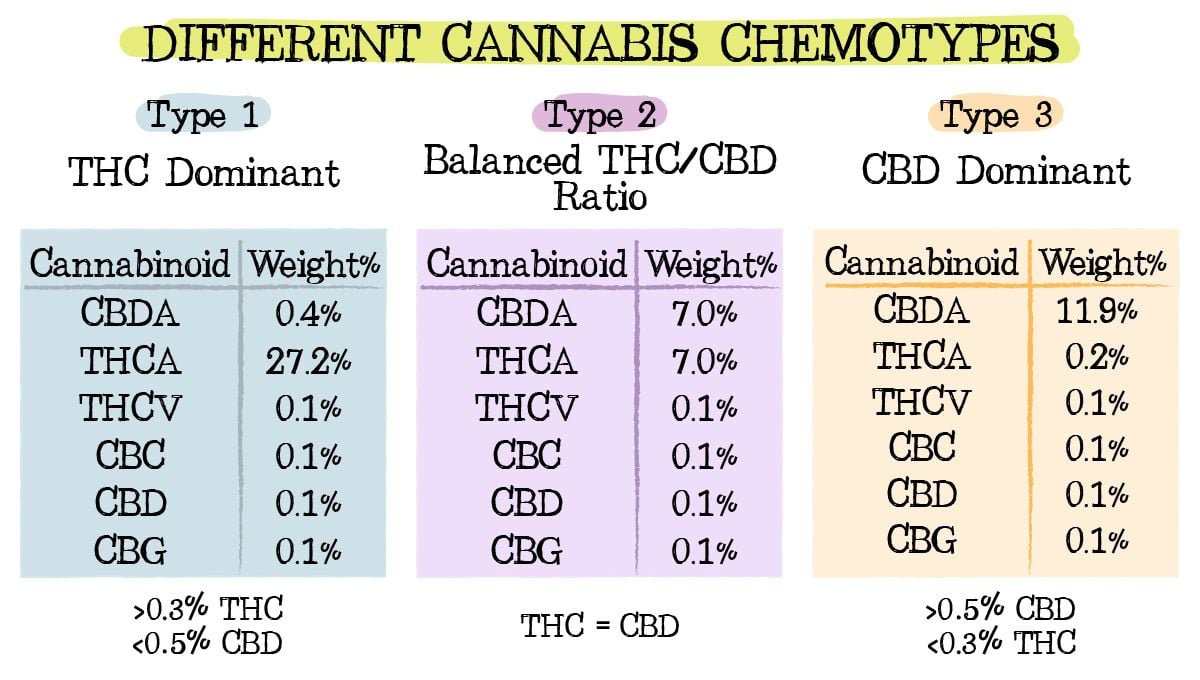
Type 2: Balanced THC/CBD ratio
Type 2 chemotypes are not as common as type 1 but are increasing in popularity. This type of cannabis offers a 1:1 THC to CBD ratio and is usually consumed by those who use cannabis for its medicinal properties but still want to feel the psychoactive effects cannabis offers.
Type 3: CBD dominant
Similar to type 2, type 3 is not very common but has increased in popularity due to recent research exposing the benefits of consuming CBD. Chemotype 3 is usually preferred by consumers with a low tolerance or for those consuming cannabis strictly for its medicinal benefits.
Apart from the three main chemotypes, researchers have recently discovered two additional chemotypes, they are:
Type 4: CBG dominant
CBG-dominant strains are hard to come by due to breeders focusing on what consumers want the most. Despite being hard to come across, there are some breeders currently working on type 4 cannabis but we still don’t know much about this chemotype due to not having enough information yet.
Type 5: Zero cannabinoids
First identified back in 2005, researchers have found that there are cannabis plants with no cannabinoids at all. Type 5 cannabis is not sought after by consumers but it could be perfect for industrial purposes because there’s no need to deal with legality and regulations due to not containing cannabinoids at all.
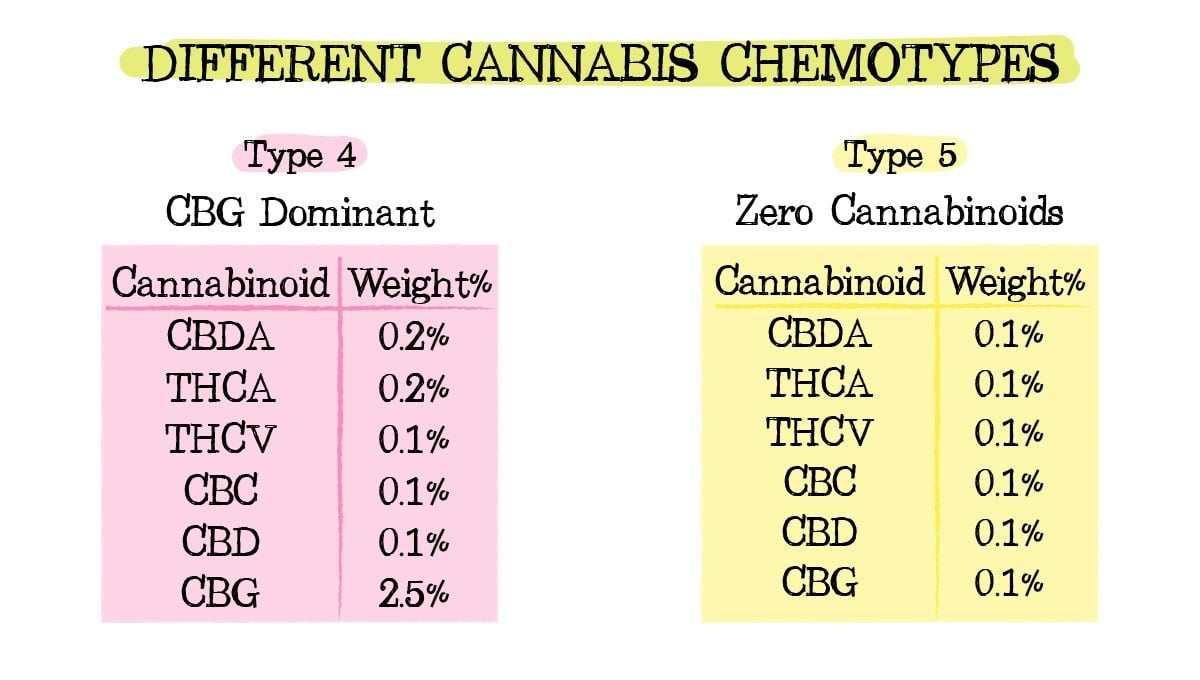
Dividing cannabis into the chemotypes mentioned is a good way to organize and categorize cannabis but it’s not perfect. Depending on the cannabinoid content, there can be a huge difference in cannabis within the same chemotype. For example, a cultivar with 4% THC and 1% CBD and one with 10% THC and 2% CBD are both type 1 but one has more THC than the other, so the effect can be much more potent, and it doesn’t take in consideration the terpene profiles, so this is where chemovars come in.
4. Cannabis Chemovars: The Next Big Thing?
Unlike chemotypes, chemovars are determined by the cannabinoid and terpene ratio. Categorizing cannabis plants by chemovars depends on full chemical analysis to know exactly which cannabinoids and terpenes a plant contains in order to be able to divide them by their potential effects. Unfortunately, this is almost impossible in some countries due to cannabis prohibition, not being cheap or the standard (yet), so scientists don't have enough data to make an official chemovar categorization, but most cannabis plants contain a terpene profile composed of the following terpenes:
Most Common Cannabis Terpenes
| Terpene | Effect | Terpene | Effect | ||
|---|---|---|---|---|---|
| Myrcene | Sedative, Muscle relaxant | Bisabolol | Antioxidant, Anti-inflammatory | ||
| Caryophyllene | Pain-relief, Anti-inflammatory | Pinene | Enhances memory retention, Bronchodilator | ||
| Linalool | Anti-anxiety, Sedative | Terpinolene | Antifungal, Antibacterial | ||
Scientists believe chemovars are key for healthcare professionals to better recommend cannabis for those medical consumers and for recreational consumers to get the most out of their experience when consuming cannabis. This is because the chemovar approach is more precise and takes more things into consideration than chemotypes so it allows a better comprehension for those who want to predict a certain plant’s effect. Now, due to being a relatively recent discovery in cannabis, there isn’t an official categorization but using the terpenes as a guide it’s considered way better than trial and error, which is what most consumers go through at the moment.
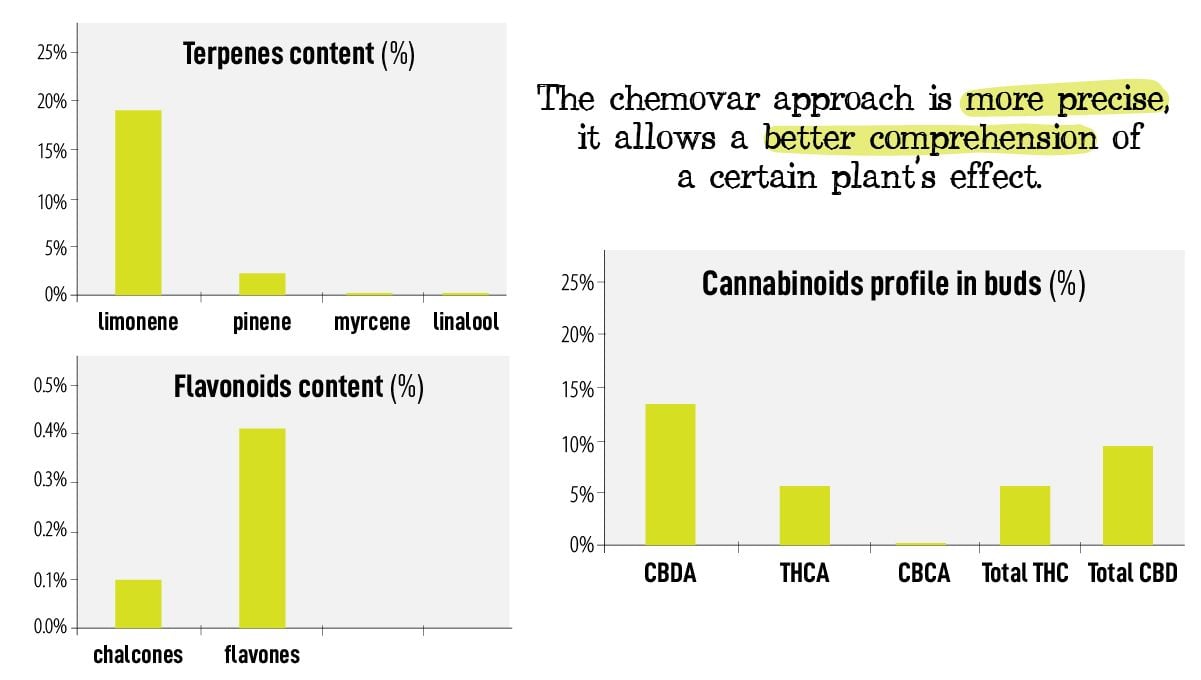
The chemovar approach requires chemical tests in order to be able to look at the chemical compounds and their concentrations, which makes it hard to study and implement in most places due to cannabis being illegal. But experts claim that categorizing by chemovar types is crucial in the cannabis industry in order for consumers to find the best product for them. This is because, unlike chemotypes, chemovars take into consideration the main cannabinoids and terpenes, so despite not being perfect it gives you more information thus increasing the chances of having a better experience than when choosing a cannabis product simply by the strain name or THC to CBD percentage.
5. In Conclusion
Chemovar and chemotypes are not perfect because it doesn’t give you an exact answer because we still don’t know all the chemical compounds in cannabis yet but hanks to legalization, researchers have been able to identify several new terpenes and cannabinoids that we should definitely take into consideration when selecting our cannabis or cannabis products, but we’re still not there yet.
As the cannabis market grows, consumers are getting to know more and more about cannabis and the two terms mentioned in this article provide a new way to understand the benefits cannabis has to offer, providing recreational and medical consumers with an easier way to find what they want or need, helping both consumers and the scientific community work together for a greater good.
If you know more about chemotypes and chemovars, feel free to share your knowledge with fellow growers by leaving a comment in the comment section below!








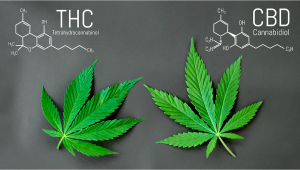
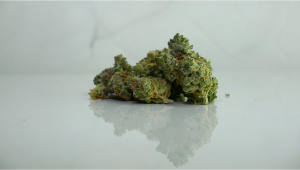
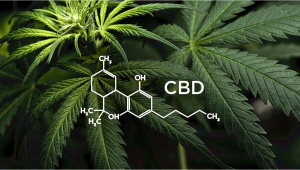
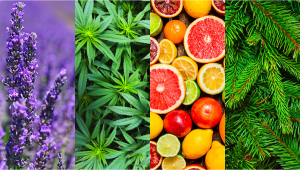


Comments